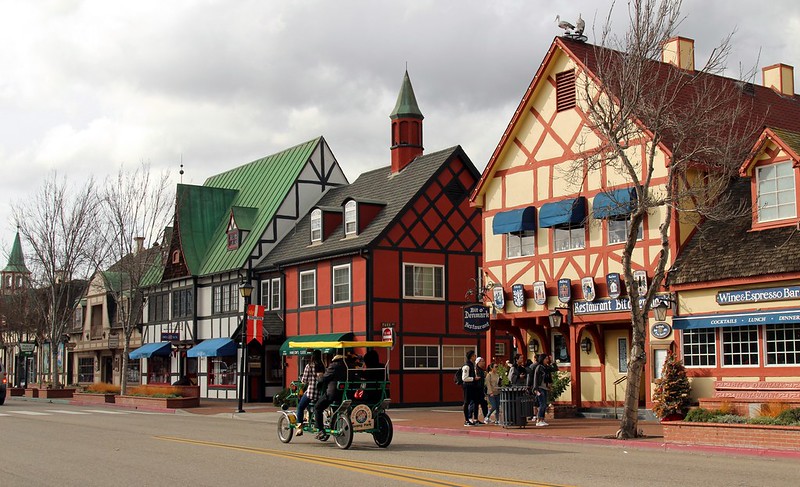I’m an urbanist and a sometime architecture critic, so I'm supposed to hate Solvang. The ersatz windmills. The fake half-timber walls. The fairy-princess towers. The kitschy buildings housing kitschy stores selling kitschy curios.
Did I mention the windmills?
Solvang is so ridiculous, it seems like it doesn’t even know the difference between Danish and Dutch. It goes nuts for anything with an umlaut.
Or so I thought until a few weeks ago, when I visited Solvang for the first time in decades. What I found, beneath the ornament and frivolity, is a town that every city in California should aspire to become. Solvang’s secret is that it isn’t a fake town. It’s a real town only pretending to be a fake town.
For starters, Solvang has real history. Mission Santa Ines is as exquisite as it is problematic. It is a quintessential California Mission, with whitewashed walls and a bell tower not quite as tall as you’d expect and yet in perfect proportion with the rest of the complex, and therefore a potent symbol of genocide and subjugation. That’s real architecture and real history. How a place like Solvang grew up around it is beyond me.
Solvang gets attention for its style. It deserves attention for its substance. Fake windmills are no more or less admirable than fake arcades or fake tile roofs. Modernism taught us that style doesn’t matter, and postmodernism taught us that styles don’t matter. Timbers aren’t any less fake than girders. So I don’t care whether Solvang has windmills, bell towers, clock towers, or molehills. Solvang would be a tourist trap whether it’s Dutch or Danish or Spanish or Swedish. If you don’t believe me, check out downtown Santa Barbara, just 40 miles down Highway 101.
So let’s get over ourselves.
Solvang succeeds because it has good bones: the streets, the massing, the public realm, the relationship among buildings, the relationship between buildings and streets — and the way the urban landscape makes people feel.

Solvang’s main street, Mission Street, includes a predictable mix of restaurants, gift shops, and bakeries, with the odd second-floor office above. And a pleasant canopy of street trees. Something wonderful happens when you turn off Main Street: more of the same. More bakeries. More gift shops. More hanging signs. More half-timbers, more trees, and more umlauts. This pattern repeats itself for several blocks in several directions. In Solvang, you can walk out the door of one store, turn a corner, walk a block, turn another corner, and walk into another store.
If this doesn’t sound like much, that’s because it’s not. But by California standards, it’s a revelation. If you don’t think so, then ask yourself why a town of 5,900 residents has 18 hotels.
If we disregard the outliers — the big city downtowns and the idiosyncratic gems like Santa Barbara — the vast majority of California cities are built around strip malls (especially suburbs) and, at best, main streets (small towns). Many of California's most beloved small towns consist of little more than a single commercial main street. Consider Bishop, Weaverville, Willits, Truckee, Idyllwild--even Ojai. They're charming, but the charm diminishes the moment you turn a corner.
The number of towns in which the “grid” includes more than a single street and more than 2-3 blocks is miniscule. Compare that with Europe, where almost every town, no matter its size, is built around a complete, pre-automobile core.
Most cities and towns in California — and across the country — allow their downtowns to languish so their outskirts can thrive, chewing up cheap land and generating tax revenue. Of course, that’s a ridiculous bargain. The more city centers thrive, the more outskirts thrive. And the bigger those city centers are, the better the towns are.
Naturally, even a state as large as California probably can’t handle more than one Danish capital. We don’t need another Solvang. And yet, other cities could take inspiration from it. They can mimic its streetscape, devise new design standards, and create something functional, attractive, and authentically Californian (whatever that may be).
Fortunately, this is not some Hans Christian Andersen fairy tale. Thanks to a combination of demographic pressure, state policies (like SB 375), and changing tastes, California cities are upzoning, and they are expanding their downtowns. I’m thinking of places as dissimilar as Truckee, Temecula, and, almost, Redlands (where a downtown density plan was voted down last week). They are welcoming density. In its own fake way, Solvang illustrates that these efforts will be worthwhile.
Maybe European-style urbanism doesn’t mean tilting at windmills after all. As for actual windmills: I think Solvang’s got us covered.
Image courtesy of Prayitno, via Flickr.


